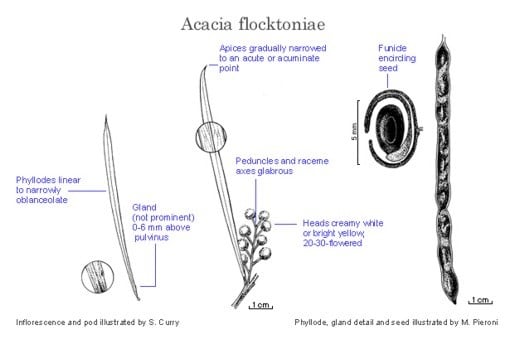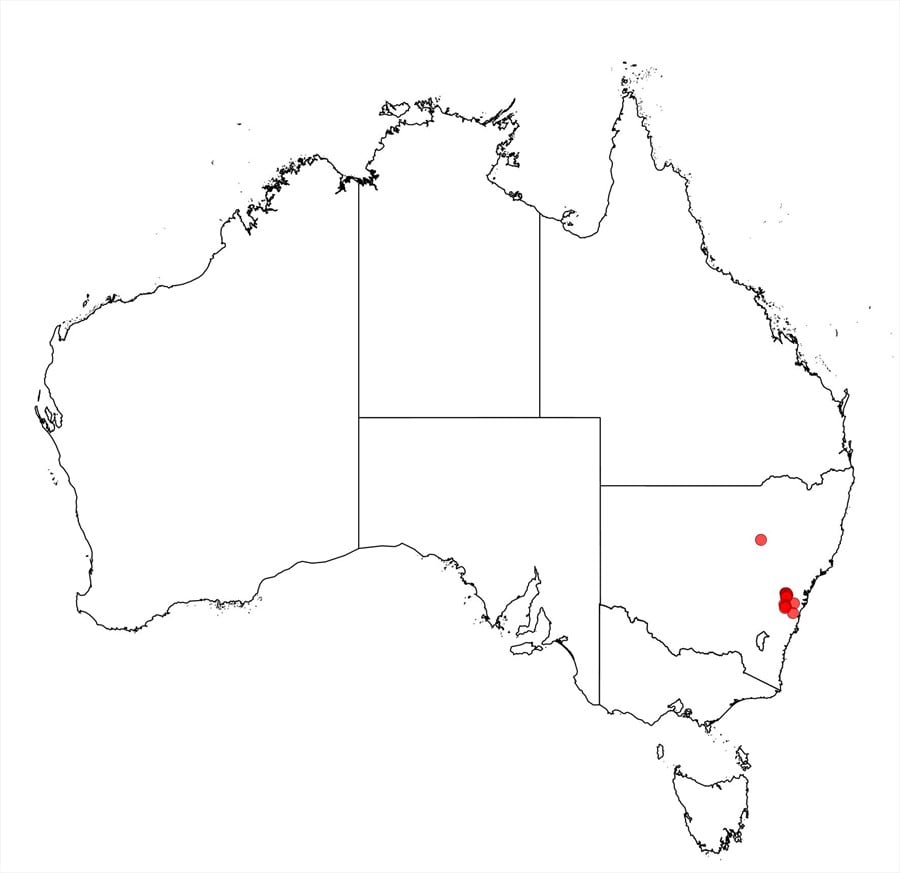Acacia flocktoniae Maiden
WATTLE
Acacias of Australia
Family
Fabaceae
Distribution
Occurs in the Blue Mtns at Mt Victoria and Megalong Valley, at Byrnes’ Gap near Yerranderie and also the Nepean R. (type of A. lunata var. crassiuscula), N.S.W.
Description
Sparingly branched, weak shrub 2–4 m high. Branchlets somewhat pendulous, angled at extremities, red-brown, glabrous. Phyllodes rather crowded, on raised stem-projections, ascending to erect, straight to ±shallowly curved, linear to narrowly oblanceolate, mostly 5–9 cm long, 2–5 mm wide, normally gradually narrowed to an acute or acuminate apex, thin, glabrous, with fine midrib, obscurely penninerved; gland not prominent, 0–6 mm above pulvinus. Inflorescences racemose, with raceme axes (1–) 2–6 cm long, slender, glabrous; peduncles (2–) 3–5 (–8) mm long, to 8 mm long in fruit, glabrous; heads globular, densely 20–30-flowered, creamy white or bright yellow. Flowers 5‑merous; sepals united almost to apex. Pods broadly linear, to 13 cm long, 5–7 mm wide, firmly chartaceous to thinly coriaceous, glabrous. Seeds longitudinal, oblong, 4.5–5.5 mm long, slightly shiny, black; funicle encircling seed in a double fold, red-black; aril clavate.
Habitat
Grows on sandstone in dry sclerophyll forest.
Specimens
N.S.W.: Byrnes’ Gap, 3.2 km NNW of Yerranderie, E.F.Constable 5648 (NSW, PERTH); Megalong Valley, 7 Nov. 1961, O.D.Evans s.n. (NSW).
Notes
A member of the ‘Acacia microbotrya group’ with phyllode shape similar to those of A. uncifolia which occurs in southern coastal areas of Vic., Tas. and S.A. and is a dense bushy shrub or tree 5–10 m high with uncinate or subuncinate phyllodes 3–6.5 cm long and 3–10 mm wide. Acacia flocktoniae is closely related to A. forsythii and apart from being geographically disjunct the two appear to differ most significantly in their habit, flower-head colour and phyllode apices. There are also slight, but overlapping, differences in the length of their racemes and peduncles and the distance of the gland above the pulvinus.
L.Pedley, Austrobaileya 1: 286 (1980), regarded A. lunata var. crassiuscula as conspecific with A. hamiltoniana, see B.R.Maslin, Telopea 6: 43–49 (1994), for discussion.
FOA Reference
Data derived from Flora of Australia Volumes 11A (2001), 11B (2001) and 12 (1998), products of ABRS, ©Commonwealth of Australia
Author
B.R.Maslin
Minor edits by B.R.Maslin & J.Rogers
This identification key and fact sheets are available as a mobile application:
URL: https://apps.lucidcentral.org/wattle/
© Copyright 2018. All rights reserved.







